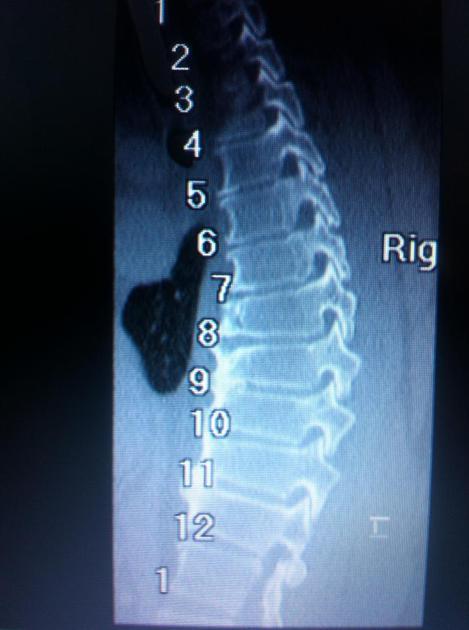Last Updated on December 2, 2022
Scheuermann disease or Scheuermann kyphosis is a disorder of childhood that results in rounding of the upper back due to wedge wedge-shaped vertebrae, resulting in kyphosis. Patients have an increased kyphosis in the thoracic or thoracolumbar spine with associated backache and localized changes in the vertebral bodies.
The wedging should be more than 5 degrees and in 3 or more consecutive vertebrae
Typically, kyphosis is more pronounced in the thoracic spine.
The condition is also known as juvenile kyphosis.
Different studies have reported a prevalence of 0.4 to 8% in the general population.
It is the most common type of structural kyphosis in adolescents. Generally, males are affected 2-7 times more than females.
Pathophysiology of Scheuermann Kyphosis
The exact mechanism in pathophysiology is not known. Several theories have been suggested which include
- Necrosis of anterior apophyseal ring
- Herniation of disc material causing loss of anterior height
- Compression deformity resulting because of osteoporosis
- altered biomechanics
However, none of the theories have been proven till now.
The most accepted mechanism [probable] is vertebral wedging and thus kyphosis is caused by a developmental collagen aggregation error resulting in an abnormal end plate.
There is an autosomal dominant inheritance pattern associated with Scheuermann kyphosis.
Associated Conditions
- Increase in Lumbar lordosis
- Scoliosis
- Lumbar spondylolysis
- Dural cysts
- Muscle tightness
- Anterior shoulder
- Hamstrings
- Iliopsoas muscle
- Cardiopulmonary issues in case of larger curves
Types of Scheuremann Kyphosis
Thoracic Type
- Curve from first/second thoracic vertebra to T12 or L1
- Apex lies somewhere between T6-T8
- Better prognosis
- More common
Thoracolumbar/lumbar Scheuermann’s Kyphosis
- Curve is lower
- From T4 or T5 to L2 or 3
- Apex at T12-L1 area
-
Features
-
Rarer
-
More symptomatic [back pain]
-
More progressive
-
more irregular end-plates on x-rays
-
Vertebrae are less wedged than other types
-
Presentation of Scheuermann Kyphosis
The disease affects boys more than girls. The most common age of presentation is 13-16 years.
Deformity or poor posture is the chief complaint. Pain is not a major complaint but can occur in upper and mid back. Complaint of pain is more common in adults than adolescents.
On examination,
- visible kyphosis that worsens on bending forward
- Hunchback or rounded back may be noticed
- decreased flexibility of the spine
- increased lumbar lordosis
- Tightness of hamstrings
The seventh and tenth thoracic vertebrae are most commonly affected.
- Following complications may occur in severe long-standing cases
- Neural compromise – rare
- Cardiopulmonary issues due to a decrease in thoracic space
Differential Diagnoses
Scheuermann kyphosis needs to be differentiated from postural deformity and other conditions causing kyphosis, especially congenital kyphosis and skeletal dysplasias.
Imaging
X-ray
A lateral x-ray of the spine would typically demonstrate

- Wedge-shaped vertebrae [Greater than 5 degrees of angulation in three consecutive vertebra at least]
- Round and rigid kyphosis [A rigid kyphosis does change with posture]
- Narrow intervertebral disc spaces with calcifications
- Irregular endplates of the vertebrae
- Schmorl’s nodes (Represents disc herniation into vertebral endplate)
- Scoliosis
- Increased lumbar lordosis
Spondylolysis should be looked for in painful backs in adolescents.
Hyperextension x-ray [x-ray is taken by hyperextending spine over a bolster] can differentiate Scheuermann kyphosis from postural kyphosis.
Sorenson criteria for diagnosis
- Kyphosis greater than 40°
- Irregular upper and lower vertebral endplates with loss of disk space height
- Wedging of 5° or more in 3 consecutive vertebrae
CT/MRI
These are often not required. MRI can be used to assess soft tissue and neural structures before surgery.
Treatment of Scheuermann Kyphosis
Most patients may not require any treatment as the deformity is mild and does not affect daily functions.
Patients with mild disease [kyphosis less than 60 degrees] were just monitored.
Physical therapy can be initiated that includes core, stretch, back strengthening exercises. Weight-bearing stress and strenuous activity should be avoided.
These measures are not very effective though.
In symptomatic patients, the treatment aims to
- To relieve pain
- To correct an unacceptable deformity
- To prevent potential progression or worsening of the curve.
Treatment will depend on
- The size of the curve
- The flexibility of the curve
- The patient’s age
- The patient’s preferences.
The treatment usually consists of following
- Spinal brace – Modified Milwaukee brace, DuPont brace
- Rest with back on the bed (recumbent position).
- Nonsteroidal anti-inflammatory drugs.
Surgery for Scheuermann kyphosis
Surgery is rarely needed for Scheuermann’s disease. It may be considered for patients with
- Severe deformities with more than 75 degrees of kyphosis
- Neurological deficits/cord compression
- Severe pain in adults
The goal of the surgery is mostly to reduce the deformity, although some feel it can lessen the pain if present.
The surgical procedure done is posterior spinal fusion with or without osteotomy. Anterior tissue release can be added if required.
Dual rod and pedicle screw construct are used to fix the fused spine.
Disc removal and anterior release is added if needed. Motor and sensory evoked potentials must be monitored intraoperatively in such cases.
Complications
- Neurological complications
- Junctional kyphosis- proximal and distal junction of fusion
- Pseudarthrosis
- Failure of the implant
- Superior mesenteric artery syndrome
References
- Bradford DS, Moe JH, Montalvo FJ, Winter RB. Scheuermann’s kyphosis. Results of surgical treatment by posterior spine arthrodesis in twenty-two patients. J Bone Joint Surg Am. 1975 Jun. 57 (4):439-48. [Link]
- Tsirikos AI. Scheuermann’s Kyphosis: an update. J Surg Orthop Adv. 2009 Fall. 18 (3):122-8. [Link]
- Horn SR, Poorman GW, Tishelman JC, Bortz CA, Segreto FA, Moon JY, et al. Trends in Treatment of Scheuermann Kyphosis: A Study of 1,070 Cases From 2003 to 2012. Spine Deform. 2019 Jan. 7 (1):100-106. .
